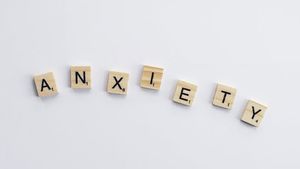JAKARTA - When anxiety strikes, it often creates a series of sensations in the form of racing thoughts, fears, and physical tensions. The mind is racing through the worst scenario, giving a grim picture of what will happen.
So, is anxiety basically an emotional response or more a mental experience? Let's investigate this question more deeply in order to get a clearer understanding.
Anxiety is categorized as emotional. But it can be seen as an emotional and mental experience, as it involves complex interactions between thoughts, feelings, and behavior.
Symptoms of mental and emotional anxiety often interact in a cyclic manner, exacerbate each other. For example, someone who experiences rutinization disorders or raging thoughts will begin to become overwhelmed emotionally. So that this can increase feelings of fear or worry.
This emotional response can then worsen mental symptoms, causing increased ruminations and excessive worries. This cycle can continue, with each series of symptoms strengthening each other, creating an increasing cycle of anxiety.
A 2022 study, cited from Psych Central, Wednesday, June 5, explores how individuals experience and understand ruminations and concerns, which are the main characteristics of depression and anxiety disorders.
Through an online survey, participants were asked about definitions, triggers, frequency, duration, and countermeasures related to ruminations and concerns.
This study found that individuals often reflect or worry about:
Social situation and negative events are the most common triggers. Although looking for distraction is a common strategy in dealing with anxiety, many participants struggle to quit the rumination and worry.
This shows how the emotional and mental aspects of anxiety work on a cycle, each affecting each other and perpetuating the anxiety experience.
Mental anxiety and emotional anxiety are closely related but can be distinguished based on focus and nature.
Emotional anxiety is especially characterized by feelings of discomfort, worry, or fear. Often this is more direct and related to certain situations or triggers, such as fear of speaking in public or anxiety about performance.
On the other hand, mental anxiety involves more cognitive aspects, such as racing thoughts, overthinking, and excessive worries about the future. This can be more common and less tied to certain triggers.
SEE ALSO:
Fear is often described as a response to direct threats, while anxiety is more an anticipation of future threats or the dangers it feels. Fear is a natural and emotional response that can be beneficial in certain situations, while anxiety is more persistent and can interfere with everyday life.
However, research in 2021 shows that distinguishing fear and anxiety in the brain is more complicated than previously thought. Although research on animals shows different brain areas for fear and anxiety, research on humans provides a more complex picture.
This requires more research to really understand how fear and anxiety work in the human brain.
The English, Chinese, Japanese, Arabic, and French versions are automatically generated by the AI. So there may still be inaccuracies in translating, please always see Indonesian as our main language. (system supported by DigitalSiber.id)


















